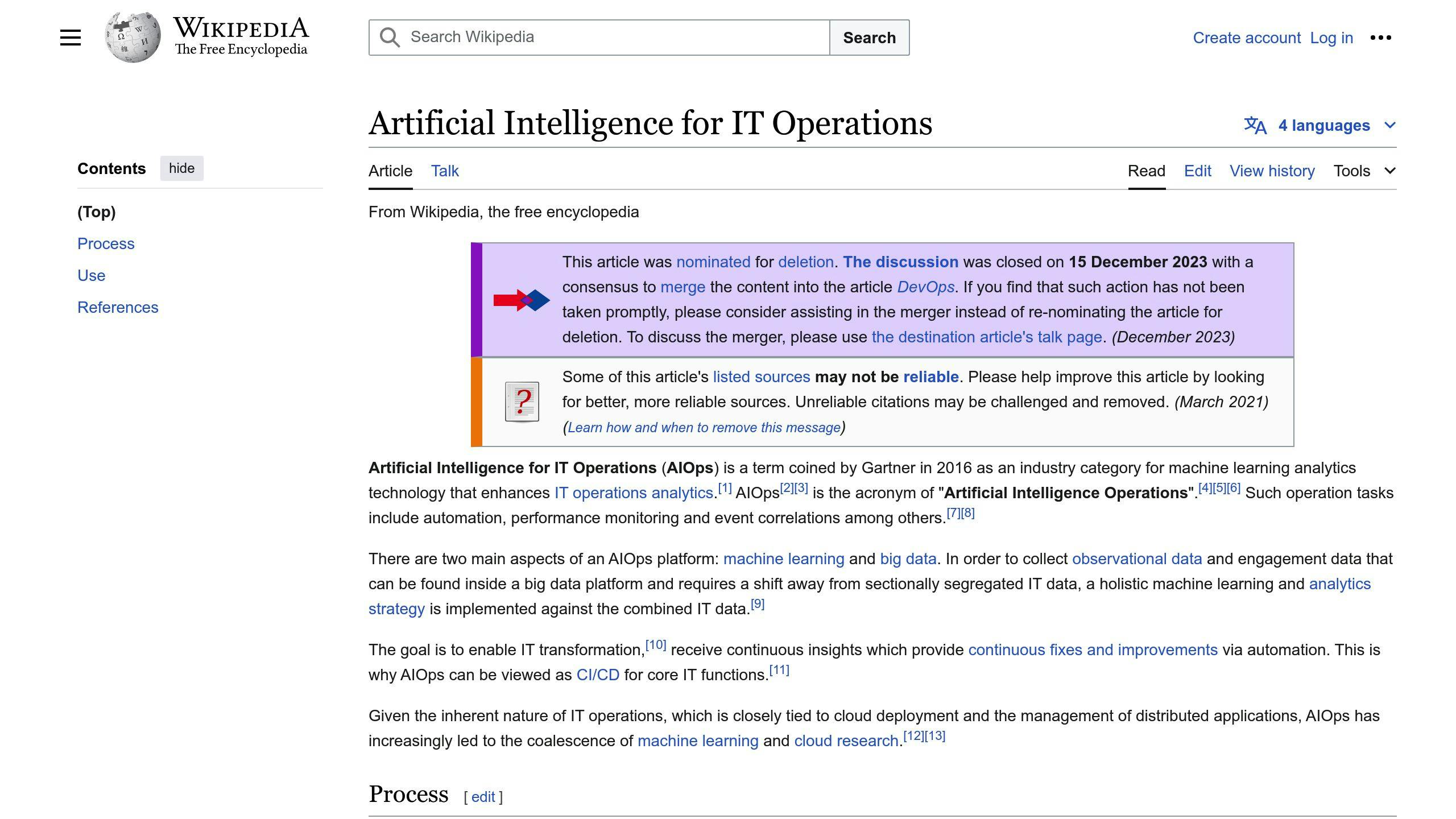No-code AIOps uses artificial intelligence (AI) and machine learning (ML) to automate and improve IT processes without requiring extensive coding skills. This technology enables IT teams to focus on strategy and innovation rather than manual, time-consuming tasks.
Related video from YouTube
Why No-code AIOps Matters

Traditional IT operations often struggle to keep up with the pace of change, leading to delays, errors, and inefficiencies. No-code AIOps provides a more agile and efficient way to manage IT operations by:
- Automating routine tasks
- Providing real-time visibility and insights
- Enabling faster deployment and iteration
- Reducing costs associated with manual labor
- Improving overall efficiency and responsiveness
Key Benefits
| Benefit | Description |
|---|---|
| Quick Deployment | Rapidly deploy AI/ML models and automated workflows |
| Wider Access | Make AIOps accessible to a broader range of IT professionals |
| Lower Costs | Reduce operational costs by minimizing coding needs |
| Faster Results | Achieve results faster by streamlining development |
| Improved Collaboration | Foster collaboration and knowledge sharing across IT teams |
| Flexible and Scalable | Adapt to changing business requirements and handle increasing data volumes |
Comparison: No-Code AIOps vs. Traditional Coding
| Feature | No-Code AIOps | Traditional Coding |
|---|---|---|
| Deployment Speed | Faster with drag-and-drop tools | Slower due to manual coding and testing |
| Cost | Lower costs by reducing specialized developer needs | Higher costs for extensive development and maintenance |
| User Access | Accessible to non-technical users | Requires technical expertise and coding skills |
| Flexibility | Flexible, but with some customization limits | Highly flexible and customizable |
No-code AIOps platforms offer quicker deployment, lower costs, and broader user access, while traditional coding approaches offer greater flexibility and customization capabilities.
As digital transformation continues, adopting innovative solutions like no-code AIOps is crucial to enhance IT operations, drive business growth, and stay ahead of competitors.
The Growing Need for Simple IT Operations
IT systems have become more complex over time, making traditional tools inadequate for handling the scale, speed, and diversity of modern environments. Manual monitoring and management can no longer keep up, leading to delays, errors, and inefficiencies. This has created a growing demand for no-code AIOps solutions that automate routine tasks, provide real-time visibility, and enable faster deployment of new services and applications.
More Intricate IT Systems
As organizations adopt cloud, containers, microservices, and other technologies, their IT systems have grown more intricate. This complexity has surpassed the capability of manual processes, making traditional tools insufficient for managing today's IT environments. No-code AIOps solutions are designed to handle this intricacy, offering a more efficient and effective way to manage IT operations.
Limitations of Traditional Coding
Traditional coding approaches have several drawbacks:
| Drawback | Description |
|---|---|
| Specialized Knowledge | Requires specific coding skills |
| Slower Innovation | Manual coding can delay new service deployment |
| Error-prone | Coding errors can lead to issues |
No-code AIOps solutions provide a more agile and flexible way to manage IT operations, enabling faster deployment and iteration of new services and applications.
Empowering Non-Technical Users
No-code AIOps solutions allow non-technical staff to use automation tools, broadening the user base and speeding up solution deployment. This enables organizations to tap into the collective knowledge and expertise of their IT teams, rather than relying solely on specialized coding skills. By empowering non-technical users, no-code AIOps solutions can help organizations:
- Improve collaboration
- Reduce costs
- Increase the speed and agility of their IT operations
sbb-itb-9890dba
Key Benefits of No-code AIOps
No-code AIOps offers many advantages that transform how IT operations are managed. By using AI and machine learning without extensive coding, organizations can streamline operations, cut costs, and boost collaboration.
Quick Deployment and Iteration
No-code AIOps platforms enable rapid deployment of AI/ML models and automated workflows. This allows organizations to quickly adapt to changing business needs. With no-code AIOps, IT teams can iterate quickly without coding delays, reducing time-to-value and realizing benefits faster.
Wider Access and Adoption
No-code interfaces make AIOps accessible to a broader range of IT professionals. This promotes wider adoption and enables organizations to tap into the collective knowledge of their IT teams, rather than relying solely on specialized coding skills.
Lower Costs and Faster Results
No-code AIOps solutions offer significant cost savings compared to traditional development approaches. By reducing the need for extensive coding, organizations can lower operational costs and achieve faster results. This allows them to redirect resources to more strategic initiatives, driving business growth and innovation.
Improved Collaboration and Knowledge Sharing
No-code AIOps facilitates collaboration between IT teams, allowing them to leverage collective intelligence and domain expertise. By providing a common platform for knowledge sharing, no-code AIOps enables organizations to break down silos and foster a culture of collaboration, driving better decision-making and improved outcomes.
Flexible and Scalable Solutions
No-code AIOps platforms are designed to adapt to changing business requirements, providing flexible and scalable solutions that can handle increasing data volumes and complexity. This enables organizations to respond quickly to new opportunities and challenges, staying ahead of the competition in today's fast-paced digital landscape.
| Benefit | Description |
|---|---|
| Quick Deployment | Rapidly deploy AI/ML models and automated workflows |
| Wider Access | Make AIOps accessible to a broader range of IT professionals |
| Lower Costs | Reduce operational costs by minimizing coding needs |
| Faster Results | Achieve results faster by streamlining development |
| Improved Collaboration | Foster collaboration and knowledge sharing across IT teams |
| Flexible and Scalable | Adapt to changing business requirements and handle increasing data volumes |
Addressing Potential Challenges
When using no-code AIOps, some issues may arise that need to be handled. Here, we'll discuss common limitations and concerns with no-code AIOps and how to overcome them.
Handling Customization Limits
One worry with no-code AIOps is limited customization. Since these platforms use pre-built templates and drag-and-drop tools, customizing them to meet specific needs can be hard. However, many offer APIs and integration options to extend functionality and connect with other systems.
Another limit is the potential complexity of integrating with existing systems. Connecting no-code AIOps to current IT infrastructure can be time-consuming and resource-heavy. To address this, develop a clear integration plan and work closely with the platform provider for a smooth process.
Integrating with Current Systems
Integrating no-code AIOps with current systems is key to getting full value. To ensure successful integration:
- Develop a clear integration plan and roadmap
- Identify and prioritize key integration points based on business needs
- Work closely with the no-code AIOps provider for smooth integration
- Thoroughly test and validate to ensure seamless integration
Maintaining Security and Compliance
Maintaining security and compliance is crucial when using no-code AIOps. Ensure the platform provider has robust security measures like data encryption, access controls, and regular audits. Additionally:
| Action | Description |
|---|---|
| Develop a security strategy | Have a clear plan for no-code AIOps security and compliance |
| Conduct regular audits | Perform security audits and risk assessments regularly |
| Control access | Ensure users have appropriate access controls and permissions |
| Monitor for threats | Monitor the platform for security breaches and vulnerabilities |
Comparing No-Code AIOps and Traditional Coding
The table below contrasts the key aspects of no-code AIOps and traditional coding approaches:
| Feature | No-Code AIOps | Traditional Coding |
|---|---|---|
| Deployment Speed | Faster with drag-and-drop tools | Slower due to manual coding and testing |
| Cost | Lower costs by reducing specialized developer needs | Higher costs for extensive development and maintenance |
| User Access | Accessible to non-technical users | Requires technical expertise and coding skills |
| Flexibility | Flexible, but with some customization limits | Highly flexible and customizable |
No-code AIOps platforms offer quicker deployment and lower costs by minimizing coding requirements. They also enable broader user access by providing user-friendly interfaces for non-technical teams. However, traditional coding approaches offer greater flexibility and customization capabilities, though at a higher cost and slower deployment pace.
Conclusion
Key Points
In this article, we explored no-code AIOps, a modern approach to IT operations that uses artificial intelligence (AI) and machine learning (ML) to automate and streamline processes. We discussed how no-code AIOps can reduce complexity, boost efficiency, and enable non-technical users to participate in IT operations. We also compared no-code AIOps with traditional coding approaches, highlighting the advantages of faster deployment, lower costs, and broader user access.
Next Steps
As digital transformation continues, it's crucial to adopt innovative solutions like no-code AIOps. We encourage you to explore no-code AIOps solutions and discover how they can enhance your IT operations. By adopting no-code AIOps, you can unlock the full potential of AI and ML, drive business growth, and stay ahead of competitors. Take the first step today and start transforming your IT operations with no-code AIOps.
| Comparison | No-Code AIOps | Traditional Coding |
|---|---|---|
| Deployment Speed | Faster with drag-and-drop tools | Slower due to manual coding and testing |
| Cost | Lower costs by reducing specialized developer needs | Higher costs for extensive development and maintenance |
| User Access | Accessible to non-technical users | Requires technical expertise and coding skills |
| Flexibility | Flexible, but with some customization limits | Highly flexible and customizable |
No-code AIOps platforms offer:
- Quicker deployment and lower costs by minimizing coding requirements
- Broader user access by providing user-friendly interfaces for non-technical teams
However, traditional coding approaches offer greater flexibility and customization capabilities, though at a higher cost and slower deployment pace.
FAQs
How is AIOps changing the future of IT operations?
AIOps is transforming IT operations by breaking down data silos and providing full visibility across IT environments. By leveraging AI capabilities and analyzing vast amounts of data, AIOps offers a comprehensive view that traditional siloed approaches cannot match.
AIOps empowers IT teams with advanced analytics, machine learning, and automation to streamline operations, boost efficiency, and improve decision-making. Key transformations include:
- Early issue detection: AIOps continuously monitors systems and uses anomaly detection to identify potential issues before they escalate, enabling proactive remediation.
- Automated root cause analysis: Through data correlation and pattern recognition, AIOps can pinpoint the root causes of incidents, reducing mean time to resolution (MTTR).
- Predictive maintenance: By analyzing historical data and identifying trends, AIOps can predict and prevent system failures, minimizing downtime.
- Intelligent automation: AIOps automates routine tasks, freeing up IT teams to focus on strategic initiatives.
As IT environments become more complex, AIOps will be crucial in managing this complexity, ensuring optimal performance, and enabling organizations to stay agile and competitive.
| Transformation | Description |
|---|---|
| Early Issue Detection | Continuously monitors systems and uses anomaly detection to identify potential issues before they escalate, enabling proactive remediation. |
| Automated Root Cause Analysis | Through data correlation and pattern recognition, pinpoints the root causes of incidents, reducing mean time to resolution (MTTR). |
| Predictive Maintenance | By analyzing historical data and identifying trends, predicts and prevents system failures, minimizing downtime. |
| Intelligent Automation | Automates routine tasks, freeing up IT teams to focus on strategic initiatives. |


